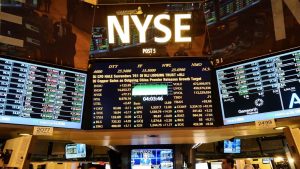FEBRUARY 27, 2020

Stocks ended sharply lower after a volatile session Thursday as traders worried that the coronavirus might be spreading in the U.S. A slew of corporate and analyst warnings on the virus also dragged down the major averages.
The Dow Jones Industrial Average plummeted 1,190 points, or 4.4%. The S&P 500 also plunged 4.4%, while the Nasdaq Composite sank 4.6%.
Those losses put the Dow, S&P 500 and Nasdaq in correction territory, down more than 10% from their record closes. It took the Dow just 10 sessions to tumble from its all-time high into a correction. The S&P 500 and Nasdaq set record highs last week.
Both the Dow and the S&P 500 had their worst day since February 2018 while the Nasdaq posted its biggest one-day loss since August 2011.
The Dow and S&P 500 are also on pace for their worst weekly performance since 2008. Through Thursday’s close, the Dow was down more than 11% week to date while the S&P 500 had lost 10.8%.
The CDC confirmed Wednesday the first U.S. coronavirus case of unknown origin in Northern California, indicating possible “community spread” of the disease. The patient had no travel history or contacts that would have put the person at risk, the CDC said. On Thursday, California Gov. Gavin Newsom said the state is monitoring 8,400 people for coronavirus.
“We’re extremely cautious in the short term,” said Tom Hainlin, a global investment strategist at Ascent Private Capital Management. “No one really seems to be an expert on the coronavirus. We haven’t seen anything like this really in our investing lifetimes.”
Apple, Intel and Exxon Mobil were among the worst-performing Dow stocks Thursday, dropping at least 6% each. AMD and Nvidia fell 7.3% and 5.6%, respectively.
President Donald Trump tried to assuage concerns over the outbreak on Wednesday. At a White House news conference, he said the risk of coronavirus to people in the U.S. is still “very low” but added that the U.S. is going to “spend whatever’s appropriate.” Trump also put Vice President Mike Pence in charge of the U.S. response to the coronavirus and said markets should soon recover.
Worries over how the coronavirus will impact corporate profits and global economic growth roiled the U.S. stock market all week as the number of confirmed cases increases. South Korea has confirmed a total of more than 1,700 cases. More than 600 people have contracted the virus in Italy.
The outbreak has also led several companies to issue warnings about its earnings and revenues.
Microsoft said Wednesday it will not meet its revenue guidance for a key segment. It said its supply chain is “returning to normal operations at a slower pace than anticipated,” which led the tech giant to cut its forecast for its personal computing division. Personal computing accounted for 36% of Microsoft’s overall revenue during the previous quarter. Microsoft shares were down 7.1%. PayPal also issued a warning about its outlook.
“US companies will generate no earnings growth in 2020,” David Kostin, Goldman Sachs’ chief U.S. equity strategist, said in a note. “Our reduced profit forecasts reflect the severe decline in Chinese economic activity in 1Q, lower end-demand for US exporters, disruption to the supply chain for many US firms, a slowdown in US economic activity, and elevated business uncertainty.”
The S&P 500 posted Thursday a six-day losing streak, be its longest daily slide since August. The Dow also had a sixth consecutive loss. That would be the 30-stock average’s longest losing streak since 2018.
Trump’s comments, Microsoft and Goldman’s warnings came after the Dow fell more than 100 points on Wednesday, adding to its massive decline for this week. Through Thursday’s close, the Dow has lost more than 3,000 points this week.
“As this week’s selling has progressed, we have seen some evidence of increased caution on the part of investors,” said Willie Delwiche, investment strategist at Baird. “Investors are shifting away from excessive optimism but there is still little evidence of fear overwhelming complacency. Bottoms are typically processes punctuated by climactic events and seeing breadth indicators stabilize would be an encouraging sign that such a process is underway.”
Bond prices, in turn, have surged this week.
The benchmark 10-year Treasury yield dipped below 1.25% on Thursday, hitting a record low, before rebounding. Earlier this month, the benchmark rate traded above 1.4%. The 30-year bond rate is also trading at an all-time low. Yields move inversely to prices.
“We’ve hit a pocket of fear,” said Gregory Faranello, head of U.S. rates trading at AmeriVet Securities. “This is a big deal. … If this flows into the U.S., we could be in trouble because, let’s face it, the U.S. consumer is what’s holding this thing together.”
Courtesy/Source: CNBC









































































































